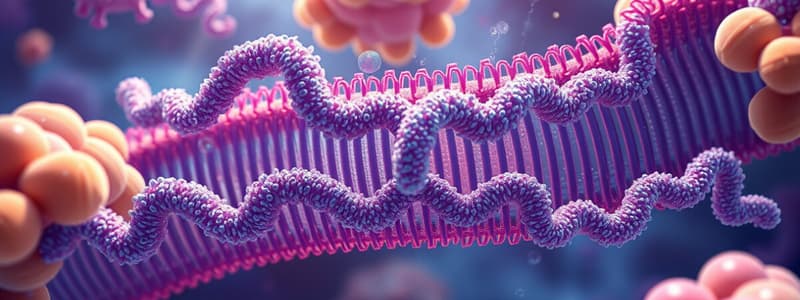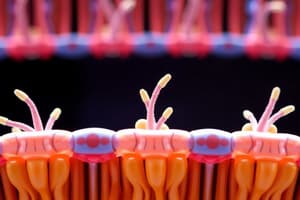Podcast
Questions and Answers
Which protein undergoes lipidation and is not a transmembrane protein?
Which protein undergoes lipidation and is not a transmembrane protein?
- APT (correct)
- Cysteine
- DHHC
- Transcription factor
How many isoforms of DHHC proteins have been identified in mammals?
How many isoforms of DHHC proteins have been identified in mammals?
- 23 (correct)
- 17
- 32
- 29
What is the primary site of synthesis for the DHHC protein?
What is the primary site of synthesis for the DHHC protein?
- Nucleus
- Endoplasmic Reticulum (ER) (correct)
- Golgi apparatus
- Ribosomes
What is the main enzymatic activity associated with DHHC proteins?
What is the main enzymatic activity associated with DHHC proteins?
Where is APT localized after lipidation to perform its function?
Where is APT localized after lipidation to perform its function?
What distinguishes APT from DHHC regarding their structure?
What distinguishes APT from DHHC regarding their structure?
Which cellular compartments are DHHC proteins primarily associated with?
Which cellular compartments are DHHC proteins primarily associated with?
What is required for a substrate to interact with DHHC proteins for lipidation?
What is required for a substrate to interact with DHHC proteins for lipidation?
What function does the reversible transmembrane protein serve compared to DHHC?
What function does the reversible transmembrane protein serve compared to DHHC?
Why is the association with cysteine critical for the lipidation process?
Why is the association with cysteine critical for the lipidation process?
What occurs to the signal sequence after the interaction with the translocon is initiated?
What occurs to the signal sequence after the interaction with the translocon is initiated?
Which factor regulates the interaction of the SRP with the signal peptide?
Which factor regulates the interaction of the SRP with the signal peptide?
What happens if there is no signal sequence present during protein synthesis?
What happens if there is no signal sequence present during protein synthesis?
What role does the SRP play in protein translation to the endoplasmic reticulum?
What role does the SRP play in protein translation to the endoplasmic reticulum?
What characterizes the nature of hydrophobic amino acids during translation through the translocon?
What characterizes the nature of hydrophobic amino acids during translation through the translocon?
When the ribosome reaches a stop codon, what is the first action taken?
When the ribosome reaches a stop codon, what is the first action taken?
What is the primary function of the structure maintained among isoforms of the DHHC protein family?
What is the primary function of the structure maintained among isoforms of the DHHC protein family?
Which part of the translation process is specifically termed 'cotranslational'?
Which part of the translation process is specifically termed 'cotranslational'?
What does the interaction between SRP and its receptor lead to in protein synthesis?
What does the interaction between SRP and its receptor lead to in protein synthesis?
What could potentially happen if there is a point mutation in the nuclear localization sequence of a protein?
What could potentially happen if there is a point mutation in the nuclear localization sequence of a protein?
Which aspect is crucial for the transport of proteins to mitochondria?
Which aspect is crucial for the transport of proteins to mitochondria?
What characteristic of translocons is important for facilitating the transport of transmembrane proteins?
What characteristic of translocons is important for facilitating the transport of transmembrane proteins?
What common sequence variation is maintained across the DHHC protein family?
What common sequence variation is maintained across the DHHC protein family?
Which consequence can arise from mutations or inhibition of palmitoylation in DHHC proteins?
Which consequence can arise from mutations or inhibition of palmitoylation in DHHC proteins?
How does histon acetylation primarily affect gene expression regulation?
How does histon acetylation primarily affect gene expression regulation?
What characteristic differentiates proteins with six transmembrane domains from those with four in the DHHC family?
What characteristic differentiates proteins with six transmembrane domains from those with four in the DHHC family?
What role do Ran-GDP proteins play in the cell?
What role do Ran-GDP proteins play in the cell?
Why is yeast often utilized as an experimental model for studying protein functions related to DHHC proteins?
Why is yeast often utilized as an experimental model for studying protein functions related to DHHC proteins?
What is the significance of the conservation of specific regions between yeast and mammals in biological research?
What is the significance of the conservation of specific regions between yeast and mammals in biological research?
What role do chaperons play in the transport of proteins to the mitochondria?
What role do chaperons play in the transport of proteins to the mitochondria?
What are TOM and TIM in relation to mitochondrial protein import?
What are TOM and TIM in relation to mitochondrial protein import?
Which statement best describes protein import into peroxisomes?
Which statement best describes protein import into peroxisomes?
How do peroxisomes differ from lysosomes and endosomes?
How do peroxisomes differ from lysosomes and endosomes?
Which statement is false regarding the synthesis of mitochondrial proteins?
Which statement is false regarding the synthesis of mitochondrial proteins?
What initiates the targeting of proteins to the rough endoplasmic reticulum?
What initiates the targeting of proteins to the rough endoplasmic reticulum?
What process is described when peroxisomes increase in number?
What process is described when peroxisomes increase in number?
In what way do peroxisome proteins differ from mitochondrial proteins in their synthesis?
In what way do peroxisome proteins differ from mitochondrial proteins in their synthesis?
What distinguishes the method of protein import into mitochondria from that into peroxisomes?
What distinguishes the method of protein import into mitochondria from that into peroxisomes?
Study Notes
DHHC PAT and APT as Transmembrane Proteins
- DHHC PAT and APT are transmembrane proteins involved in lipidation processes.
- DHHC acts as a transmembrane enzyme, promoting the transfer of palmitate to substrates, requiring a cysteine for specificity.
- APT, while not a transmembrane protein, interacts with substrates to catalyze hydrolysis and release soluble proteins.
- APT is synthesized by free ribosomes, while DHHC proteins are synthesized in the endoplasmic reticulum (ER).
Diversity of DHHC Proteins
- At least 23 mammalian DHHC isoforms exhibit specific localizations in intracellular compartments, including ER, Golgi, and plasma membranes.
- All isoforms are characterized by a common catalytic activity, despite differences in their sequences.
- Primary sequences of DHHC proteins typically contain conserved regions and structural domains (4 or 6 transmembrane domains).
- Yeast proteins similar to mammalian DHHC proteins reveal evolutionary conservation in enzymatic function.
DHHC Enzymes and Neurodegenerative Diseases
- DHHC enzymes show specificity for various substrates, including G proteins.
- Mutations or inhibition of palmitoylation in these enzymes are linked to neurodegenerative diseases.
Histone Acetylation and Protein Recognition
- Acetylation influences transcription regulation while ubiquitination targets proteins for degradation.
- Mutation of nuclear localization sequences affects protein transport, demonstrating crucial roles in cellular localization.
Protein Import into Mitochondria
- Proteins destined for mitochondria are synthesized by free ribosomes, requiring a mitochondrial localization sequence for transport.
- Chaperone proteins denature the synthesized proteins so they can pass through mitochondrial transporters (TOM for outer and TIM for inner membranes).
- The import process is energy-consuming and ensures proper folding occurs once inside the mitochondria.
Peroxisomes: Unique Features
- Peroxisomes are distinguished by high concentrations of catalase and are central to detoxification processes.
- Proteins can enter peroxisomes from the cytosol or ER, with some being synthesized by free ribosomes and others delivered via vesicular transport from the ER.
Secretion Route and SRP Function
- The majority of mammalian proteins synthesized by ribosomes associated with the ER are coded by about one-third of the genome.
- Signal recognition particles (SRP) guide the ribosomes to the ER, blocking translation until the SRP interacts with the receptor at the rough ER.
- Translation resumes once the SRP releases the signal peptide and allows the polypeptide chain to enter the translocon within the ER membrane.
Translocon Mechanism
- The polypeptide chain passes through an aqueous channel formed by the translocons located in the ER membrane.
- Specific interactions with hydrophobic amino acids determine whether regions of the polypeptide will integrate into the membrane or remain within the ER lumen.
- Upon reaching a stop codon, ribosomes dissociate, allowing recycling of the ribosomal components and translocon machinery.
Studying That Suits You
Use AI to generate personalized quizzes and flashcards to suit your learning preferences.
Description
This quiz explores the roles of DHHC PAT and APT transmembrane proteins in the lipidation process. It focuses on the enzymatic functions of these proteins, their specificity related to cysteine interactions, and their significance in protein modification. Test your knowledge on these critical cellular mechanisms.




